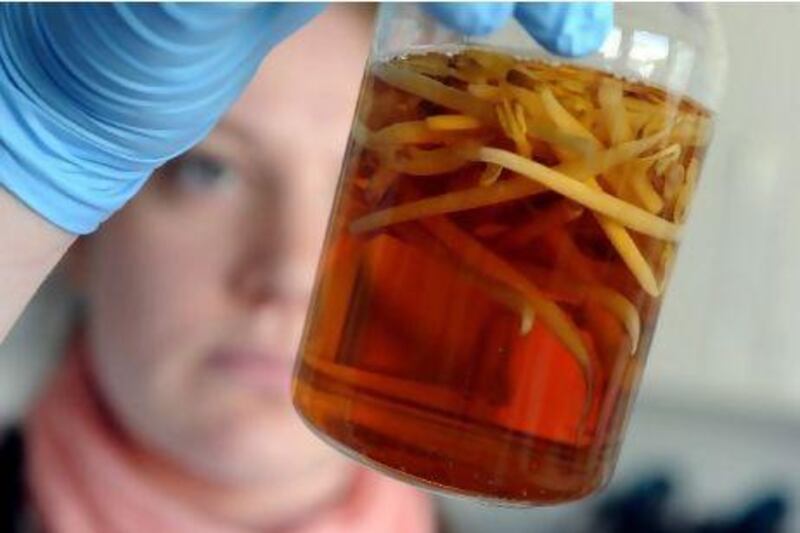HAMBURG // Even if Germany finds the source of the E coli outbreak that has infected thousands of people since early May, it may be too late for Erika.
The 66-year-old chain smokes on the grounds of a Hamburg hospital as she waits to learn if an apparently healthy salad has given her a rare and deadly disease.
"I had prepared a salad with cucumbers and tomatoes," recalls Erika, whose husband died late last year and who asked not to be identified by her full name because the symptoms she has developed are embarrassing. "I peeled the cucumbers but I did not wash them first."
She fell ill on May 19 with bloody diarrhoea. A few days later she heard about the outbreak on the radio and went to see a specialist. By then she was suffering from stomach cramps too.
Erika was sent to the university clinic for tests which showed she is one of 2,300 people infected by the outbreak of E. coli. Soon she will learn if she is one of more than 660 to develop haemolytic uraemic syndrome (HUS) where the bacteria attacks the kidneys and nervous system, gives its victims fits and often forces them onto dialysis.
The deadliest outbreak of its type on record has so far killed 25 people - almost all of them in Germany. Striking suddenly in May, the crisis has doctors struggling to explain the outbreak and public health authorities in one of Europe's most famously organised countries stumped as to how to manage it and how to stop it happening again. As the outbreak enters its second month, plenty of questions remain, not least of which is: if the Germans can't manage an outbreak, who can?
The first case in Germany's E. coli outbreak was reported on May 1. Soon an average of nine cases a day were being reported, rising to 122 cases on May 23 alone.
At first, German officials blamed cucumbers, specifically, Spanish cucumbers. Within days, though, investigators had ruled out the vegetable and started looking closer to home. Chancellor Angela Merkel was forced to explain Germany's actions to an irate Spanish prime minister and Spanish farmers later said they might sue for damages.
Germany's main centre for disease control, the Robert Koch Institute (RKI), deployed 10 teams to outbreak hotspots such as restaurants and canteens and to ask patients exactly what they ate for each course. To double check the data, customers of these establishments who did not fall ill have been interviewed too. Officials have also sifted through the contents of rubbish bins and fridges and sent some of their contents for analysis.
Specialists working around the clock at RKI headquarters in Berlin cross-check the data looking for what the institute's president, Reinhard Burger, called a "common denominator". So far that's been raw vegetables.
After a few days the search took scientists to the Kartoffelkeller (Potato Cellar) restaurant in Luebeck, north-east of Hamburg. The former medieval hospital offers traditional fare based on meat and potatoes. On May 13 it had served dinner to a large group of female tax officials. Then 17 people who had eaten there fell sick - and one of the tax officers died.
The owner Joachim Berger said health inspectors turned the place upside down without finding anything and when Reuters visited at lunchtime on June 4, the Kartoffelkeller was open for business and full. None of his staff had become ill, Mr Berger said. "Everything has been re-disinfected and inspected, but it's clear nobody here is sick, and we all eat the food ourselves."
But public health officials believed they were on the right track. On June 5, Lower Saxony state agriculture minister Gert Lindemann said a "really hot lead" pointed to sprout varieties (alfalfa, mung bean, radish and arugula) from a supplier that sold the Kartoffelkeller its vegetables. Johanna Tramma at the Fruchthof, a family firm in the state of Schleswig-Holstein, said her sprouts had come from a farm in Lower Saxony which also supplied Hamburg's wholesale market.
Perhaps the E coli detectives should have focused in on sprouts more quickly. An outbreak in Japan in 1996, which killed 11 people, was traced to a similar source, and a US outbreak in 1997 came from alfalfa sprouts.
Officials rushed to the Gaertnerhof farm in the town of Bienenbuettel in Lower Saxony. The farm's owner, Klaus Verbeck, told a local paper - before retreating behind a fence patrolled by security guards - that the Gaertnerhof had been growing organic sprouts for 25 years and was given a clean bill of health for E coli as recently as the second half of May.
In many ways the bean sprout theory sounds likely. Scientists say the steamy temperatures at which sprouts are cultivated are an ideal incubation ground for microbes.
But the sprouts may not be the culprits. Evidence so far is circumstantial and the first tests on suspect sprouts from Lower Saxony have been inconclusive, said the regional agriculture ministry.
The exact source may never be pinned down.
At the RKI, Mr Burger said: "We can't rule out that the source of the outbreak cannot be retraced anymore. That's not unusual in these circumstances," adding that the original source of the infection may no longer exist.






